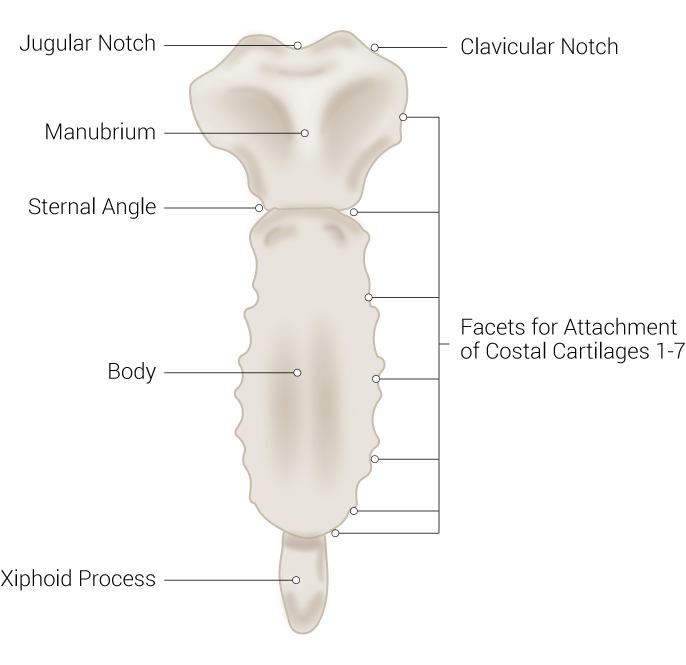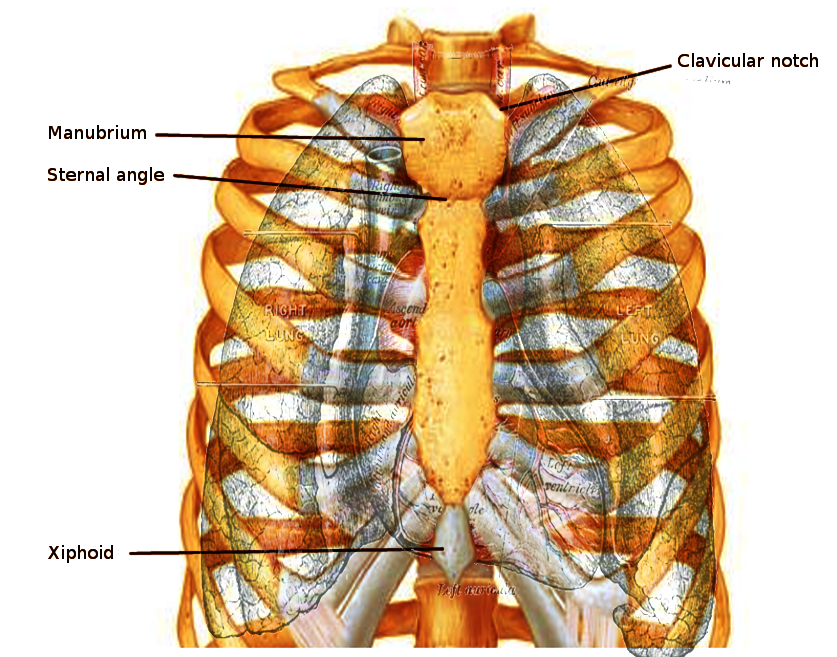[1]
Carrier G, Fréchette E, Ugalde P, Deslauriers J. Correlative anatomy for the sternum and ribs, costovertebral angle, chest wall muscles and intercostal spaces, thoracic outlet. Thoracic surgery clinics. 2007 Nov:17(4):521-8. doi: 10.1016/j.thorsurg.2007.04.003. Epub
[PubMed PMID: 18271166]
[3]
J AR, G M, K M, P R. Closing the cleft over a throbbing heart: neonatal sternal cleft. BMJ case reports. 2014 Jul 4:2014():. doi: 10.1136/bcr-2014-204529. Epub 2014 Jul 4
[PubMed PMID: 25100810]
Level 3 (low-level) evidence
[4]
Gupta M, Sodhi L, Sahni D. Variations in collateral contributions to the blood supply to the sternum. Surgical and radiologic anatomy : SRA. 2002 Dec:24(5):265-70
[PubMed PMID: 12497215]
[5]
Berdajs D, Zünd G, Turina MI, Genoni M. Blood supply of the sternum and its importance in internal thoracic artery harvesting. The Annals of thoracic surgery. 2006 Jun:81(6):2155-9
[PubMed PMID: 16731146]
[6]
Kirum GG, Munabi IG, Kukiriza J, Tumusiime G, Kange M, Ibingira C, Buwembo W. Anatomical variations of the sternal angle and anomalies of adult human sterna from the Galloway osteological collection at Makerere University Anatomy Department. Folia morphologica. 2017:76(4):689-694. doi: 10.5603/FM.a2017.0026. Epub 2017 Mar 29
[PubMed PMID: 28353306]
[8]
Choi PJ, Iwanaga J, Tubbs RS. A Comprehensive Review of the Sternal Foramina and its Clinical Significance. Cureus. 2017 Dec 8:9(12):e1929. doi: 10.7759/cureus.1929. Epub 2017 Dec 8
[PubMed PMID: 29456905]
[9]
Reser D, Caliskan E, Tolboom H, Guidotti A, Maisano F. Median sternotomy. Multimedia manual of cardiothoracic surgery : MMCTS. 2015:2015():. pii: mmv017. doi: 10.1093/mmcts/mmv017. Epub 2015 Jul 17
[PubMed PMID: 26188337]
[10]
Ates MS, Duvan I, Onuk BE, Kurtoglu M. Isolated Sternal Cleft in a Patient With Coronary Artery Disease. World journal for pediatric & congenital heart surgery. 2016 Mar:7(2):238-40. doi: 10.1177/2150135115589790. Epub 2015 Dec 23
[PubMed PMID: 26701621]
[11]
Acastello E, Majluf R, Garrido P, Barbosa LM, Peredo A. Sternal cleft: a surgical opportunity. Journal of pediatric surgery. 2003 Feb:38(2):178-83
[PubMed PMID: 12596098]
[12]
Powar RS, Prabhu A, Prabhu M. Isolated complete cleft. The Annals of thoracic surgery. 2012 Nov:94(5):1733-5. doi: 10.1016/j.athoracsur.2012.02.086. Epub
[PubMed PMID: 23098959]
[13]
Hersh JH, Waterfill D, Rutledge J, Harrod MJ, O'Sheal SF, Verdi G, Martinez S, Weisskopf B. Sternal malformation/vascular dysplasia association. American journal of medical genetics. 1985 May:21(1):177-86, 201-2
[PubMed PMID: 4003442]
[14]
Fokin AA. Thoracic defects: cleft sternum and Poland syndrome. Thoracic surgery clinics. 2010 Nov:20(4):575-82. doi: 10.1016/j.thorsurg.2010.06.001. Epub
[PubMed PMID: 20974442]
[15]
Fokin AA, Steuerwald NM, Ahrens WA, Allen KE. Anatomical, histologic, and genetic characteristics of congenital chest wall deformities. Seminars in thoracic and cardiovascular surgery. 2009 Spring:21(1):44-57. doi: 10.1053/j.semtcvs.2009.03.001. Epub
[PubMed PMID: 19632563]
[16]
Kwiecinski J. Pectus excavatum in mummies from ancient Egypt. Interactive cardiovascular and thoracic surgery. 2016 Dec:23(6):993-995
[PubMed PMID: 27481681]
[17]
Abid I, Ewais MM, Marranca J, Jaroszewski DE. Pectus Excavatum: A Review of Diagnosis and Current Treatment Options. The Journal of the American Osteopathic Association. 2017 Feb 1:117(2):106-113. doi: 10.7556/jaoa.2017.021. Epub
[PubMed PMID: 28134952]
[18]
Cobben JM, Oostra RJ, van Dijk FS. Pectus excavatum and carinatum. European journal of medical genetics. 2014 Aug:57(8):414-7. doi: 10.1016/j.ejmg.2014.04.017. Epub 2014 May 10
[PubMed PMID: 24821303]
[19]
Ramadan SU, Türkmen N, Dolgun NA, Gökharman D, Menezes RG, Kacar M, Koşar U. Sex determination from measurements of the sternum and fourth rib using multislice computed tomography of the chest. Forensic science international. 2010 Apr 15:197(1-3):120.e1-5. doi: 10.1016/j.forsciint.2009.12.049. Epub 2010 Jan 18
[PubMed PMID: 20083365]
[20]
Hunnargi SA, Menezes RG, Kanchan T, Lobo SW, Binu VS, Uysal S, Kumar HR, Baral P, Herekar NG, Garg RK. Sexual dimorphism of the human sternum in a Maharashtrian population of India: a morphometric analysis. Legal medicine (Tokyo, Japan). 2008 Jan:10(1):6-10
[PubMed PMID: 17698393]
[21]
Hunnargi SA, Menezes RG, Kanchan T, Lobo SW, Uysal S, Herekar NG, Krishan K, Garg RK. Sternal index: Is it a reliable indicator of sex in the Maharashtrian population of India? Journal of forensic and legal medicine. 2009 Feb:16(2):56-8. doi: 10.1016/j.jflm.2008.08.004. Epub 2008 Oct 1
[PubMed PMID: 19134997]
[22]
Bongiovanni R, Spradley MK. Estimating sex of the human skeleton based on metrics of the sternum. Forensic science international. 2012 Jun 10:219(1-3):290.e1-7. doi: 10.1016/j.forsciint.2011.11.034. Epub 2011 Dec 29
[PubMed PMID: 22209293]
[23]
García-Parra P, Pérez Fernández Á, Djorojevic M, Botella M, Alemán I. Sexual dimorphism of human sternum in a contemporary Spanish population. Forensic science international. 2014 Nov:244():313.e1-9. doi: 10.1016/j.forsciint.2014.06.019. Epub 2014 Jun 26
[PubMed PMID: 25102779]
[24]
Jit I, Jhingan V, Kulkarni M. Sexing the human sternum. American journal of physical anthropology. 1980 Aug:53(2):217-24
[PubMed PMID: 7416254]
[25]
Bacci N, Nchabeleng EK, Billings BK. Forensic age-at-death estimation from the sternum in a black South African population. Forensic science international. 2018 Jan:282():233.e1-233.e7. doi: 10.1016/j.forsciint.2017.11.002. Epub 2017 Nov 10
[PubMed PMID: 29195663]
[26]
Menezes RG, Kanchan T, Kumar GP, Rao PP, Lobo SW, Uysal S, Krishan K, Kalthur SG, Nagesh KR, Shettigar S. Stature estimation from the length of the sternum in South Indian males: a preliminary study. Journal of forensic and legal medicine. 2009 Nov:16(8):441-3. doi: 10.1016/j.jflm.2009.05.001. Epub 2009 Jun 17
[PubMed PMID: 19782312]
[27]
Menezes RG, Nagesh KR, Monteiro FN, Kumar GP, Kanchan T, Uysal S, Rao PP, Rastogi P, Lobo SW, Kalthur SG. Estimation of stature from the length of the sternum in South Indian females. Journal of forensic and legal medicine. 2011 Aug:18(6):242-5. doi: 10.1016/j.jflm.2011.04.004. Epub 2011 May 18
[PubMed PMID: 21771553]
[28]
Macaluso PJ Jr, Lucena J. Stature estimation from radiographic sternum length in a contemporary Spanish population. International journal of legal medicine. 2014 Sep:128(5):845-51. doi: 10.1007/s00414-014-0975-3. Epub 2014 Feb 14
[PubMed PMID: 24526040]
[29]
Marinho L, Almeida D, Santos A, Cardoso HF. Is the length of the sternum reliable for estimating adult stature? A pilot study using fresh sterna and a test of two methods using dry sterna. Forensic science international. 2012 Jul 10:220(1-3):292.e1-4. doi: 10.1016/j.forsciint.2012.02.012. Epub 2012 Mar 14
[PubMed PMID: 22421326]
Level 3 (low-level) evidence
[30]
Khoriati AA, Rajakulasingam R, Shah R. Sternal fractures and their management. Journal of emergencies, trauma, and shock. 2013 Apr:6(2):113-6. doi: 10.4103/0974-2700.110763. Epub
[PubMed PMID: 23723620]
[31]
Schulz-Drost S, Oppel P, Grupp S, Schmitt S, Carbon RT, Mauerer A, Hennig FF, Buder T. Surgical fixation of sternal fractures: preoperative planning and a safe surgical technique using locked titanium plates and depth limited drilling. Journal of visualized experiments : JoVE. 2015 Jan 5:(95):e52124. doi: 10.3791/52124. Epub 2015 Jan 5
[PubMed PMID: 25590989]
[32]
Guska S, Pilav I, Musanovic S. Clinical significance of isolated sternal fracture. Medicinski arhiv. 2010:64(1):17-21
[PubMed PMID: 20422818]
[33]
Ram P, Menezes RG, Sirinvaravong N, Luis SA, Hussain SA, Madadin M, Lasrado S, Eiger G. Breaking your heart-A review on CPR-related injuries. The American journal of emergency medicine. 2018 May:36(5):838-842. doi: 10.1016/j.ajem.2017.12.063. Epub 2017 Dec 28
[PubMed PMID: 29310980]
[34]
Hoke RS, Chamberlain D. Skeletal chest injuries secondary to cardiopulmonary resuscitation. Resuscitation. 2004 Dec:63(3):327-38
[PubMed PMID: 15582769]
[35]
Senthilkumaran S, Menezes RG, Jayaraman S, Thirumalaikolundusubramanian P. Sternal fracture after cardioversion: time to probe. The American journal of emergency medicine. 2013 Oct:31(10):1532-3. doi: 10.1016/j.ajem.2013.07.016. Epub 2013 Aug 15
[PubMed PMID: 23954362]
[36]
Milenko B, Slobodan S, Ivana C, Bojana R, Tijana D. Forensic Implications of Sternal Bone Marrow Biopsy Fatalities: Autopsy Case Report. The American journal of forensic medicine and pathology. 2018 Dec:39(4):345-347. doi: 10.1097/PAF.0000000000000425. Epub
[PubMed PMID: 30161030]
Level 3 (low-level) evidence
[37]
Asakura Y, Kinoshita M, Kasuya Y, Sakuma S, Ozaki M. Ultrasound-guided sternal bone marrow aspiration. Blood research. 2017 Jun:52(2):148-150. doi: 10.5045/br.2017.52.2.148. Epub 2017 Jun 22
[PubMed PMID: 28698857]


